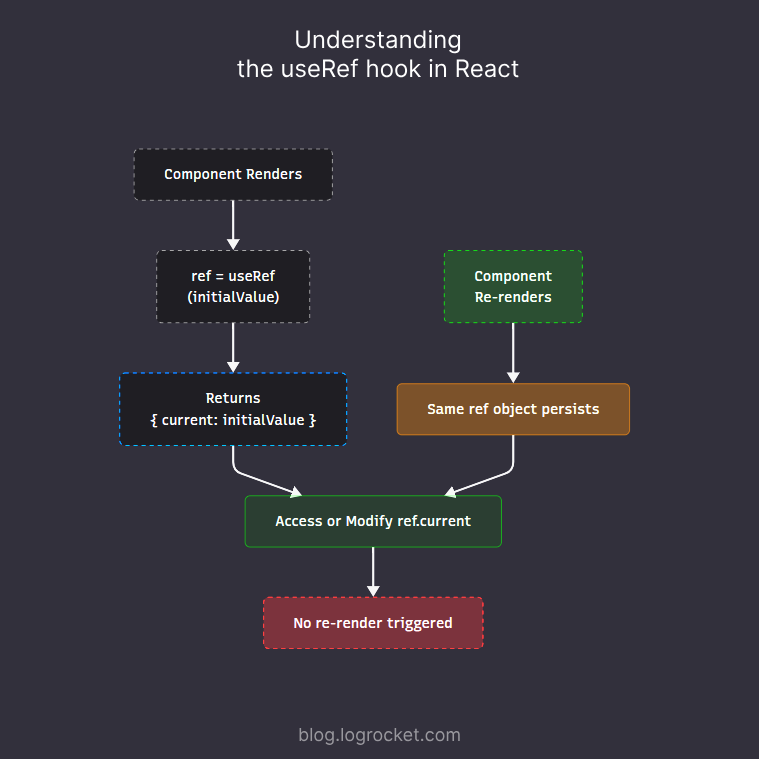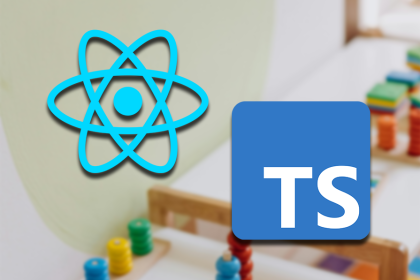useRef Hook effectively
Functional components in React utilize built-in Hooks to implement stateful behavior and lifecycle methods. One of these Hooks is useRef, which is pretty convenient for referencing values in React.

In this guide, we will examine the useRef Hook in React, learn how to use it, see some of its applications, and discuss best practices to ensure its consistent implementation in future React apps.
The Replay is a weekly newsletter for dev and engineering leaders.
Delivered once a week, it's your curated guide to the most important conversations around frontend dev, emerging AI tools, and the state of modern software.
useRef in React?When working with React, we should always utilize built-in library tools, which are created and optimized for specific scenarios. The useRef Hook is one such tool that helps us handle references to mutable values in React. It acts as a container storing a reference to a mutable value while persisting it between component re-renders.
The following flowchart illustrates the persistence of a referenced value with useRef without triggering any re-render to the corresponding component:

In technical terms, the container here is called a mutable reference object, and the value it holds is called a reference.
If you are new to React, this React Hooks cheat sheet can teach you how to use all the major Hooks in React with practical examples.
useRef syntaxWhen used, the useRef Hook returns a mutable object with a current property, which is a reference to the object’s current value.
Let’s understand useRef with an example, while also exploring its syntax and observing how it functions without triggering re-renders when its value changes:
import { useRef } from "react";
export default function Counter() {
const countRef = useRef(0);
const incrementCount = () => {
countRef.current += 1;
console.log(`Current count: ${countRef.current}`);
};
return (
<div>
<p>Check the console for updates.</p>
<button onClick={incrementCount}>Increment</button>
</div>
);
}
In the above example, the countRef variable returns a mutable reference object with zero as its initial reference value. Using the object’s current property, this value is updated whenever the “increment” button is pressed:
See the Pen
React useRef Counter example by Rahul (@c99rahul)
on CodePen.
A change in the countRef.current property here will not re-render the corresponding <Counter/> component, and that’s why we are observing changes in the developer console in this example rather than in the UI.
useRef syntaxWhen using TypeScript, it is important to specify the type of data a useRef object will hold. Here’s a quick snippet showing both simple and advanced TypeScript type specifications useRef:
interface UserInfo {
name: string;
age?: number;
}
function SomeComponent() {
const messageRef = useRef<string | null>(null);
const inputRef = useRef<HTMLInputElement | null>(null);
const userRef = useRef<UserInfo>({ name: "John Doe" });
// ...
}
useRef and useStateLike useRef, the useState Hook also persists values, but there’s a subtle difference between them.
The major difference between these two Hooks is the basic philosophy of their functioning, which broadly defines their three main distinctions:
useState Hook always provides the current state value on every render, while the useRef Hook is designed to persist values across rendersuseState always re-renders the related component, while a change in a useRef reference never changes the UIuseState, we can’t change the state directly. Instead, we use a getter-setter pattern to mutate and manage values. With a useRef object, we can directly mutate the value by modifying the current property of the reference object whenever requiredWe now have a general understanding of how useRef differs fundamentally from useState and what it can achieve on its own. For a broader overview of this differentiation, you should see this useState vs. useRef guide
useRef in ReactTo identify the need for useRef in your components, determine whether or not a value or reference should persist without dealing with renders.
Let’s look at some general applications of useRef in React that can help you decide immediately if your component really needs it.
useRefThe useRef Hook works great for handling imperative actions like DOM manipulations.
Instead of using JavaScript Web API methods, such as querySelector or getElementById, to select a DOM element in React, we utilize the useRef Hook to hold its reference.
This approach keeps the reference to that element intact across re-renders and makes things work smoothly without bypassing the virtual DOM, maintaining your app’s integrity.
Let’s access a DOM element with useRef and use this reference to get the name of the HTML tag it is built with:
function ElementTellingItsTagName() {
const elementRef = useRef(null);
const [tagName, setTagName] = useState("...");
useEffect(() => {
setTagName(elementRef.current.tagName);
}, []);
return (
<p ref={elementRef}>
This element is created using a{" "}
<{tagName.toLowerCase()}> tag. </p> ); }
Note that the empty array passed as a useEffect dependency ensures the side-effect runs only once after the component mounts and not on subsequent renders or unmounts:
See the Pen
DOM element selection with useRef by Rahul (@c99rahul)
on CodePen.
Following the same path as storing references to DOM elements, we can also manage timeouts, event handlers, and observers with useRef, which serves different purposes.
Here’s a small example keeping reference of a timeout with useRef, so that we could clear it at the time of component cleanup. This is important from a memory management perspective:
function TimeoutExample() {
const timeoutRef = useRef(null);
const [message, setMessage] = useState("Waiting...");
useEffect(() => {
timeoutRef.current = setTimeout(() => {
setMessage("Timeout completed!");
}, 3000);
// Cleanup when component unmounts
return () => clearTimeout(timeoutRef.current);
}, []);
return <p>{message}</p>;
}
Managing an observer would be slightly different, where you keep references of both the target node and the observer attached to that node:
function IntersectionObserverExample() {
const targetRef = useRef(null);
const observerRef = useRef(null);
useEffect(() => {
observerRef.current = new IntersectionObserver(
(entries) => { /* Do something */ },
{ threshold: 0.1 }
);
if (targetRef.current) {
observerRef.current.observe(targetRef.current);
}
// Clean up
return () => {
if (observerRef.current) {
observerRef.current.disconnect();
}
};
}, []);
return (
<div ...>
<div ref={targetRef}>
...
</div>
</div>
);
}
We can also utilize useRef in managing event handlers that should not be recreated on component re-renders. Here’s a quick example:
function ClickTracker() {
const clickHandlerRef = useRef(null);
const [count, setCount] = useState(0);
useEffect(() => {
clickHandlerRef.current = () => {
setCount((prevCount) => prevCount + 1);
};
window.addEventListener("click", clickHandlerRef.current);
return () => window.removeEventListener("click", clickHandlerRef.current);
}, []);
return <p>Clicks: {count}</p>;
}
As discussed, useRef allows your React components to persist mutable values between re-renders. Let’s explore this with a simple example, where we persist the previous count value in a counter component with useRef:
function Counter() {
const [count, setCount] = useState(0);
const prevCountRef = useRef(null);
const updateCount = (amount) => {
setCount((currentCount) => currentCount + amount);
};
useEffect(() => {
// Set the state value as current reference value
prevCountRef.current = count;
}, [count]);
return (
<>
<p>Current count: {count}</p>
{prevCountRef.current !== null && (
<p>Previous count: {prevCountRef.current}</p>
)}
<button onClick={() => updateCount(1)}>+1</button>
<button onClick={() => updateCount(5)}>+5</button>
</>
);
}
See the Pen
Event listeners with useRef by Rahul (@c99rahul)
on CodePen.
Note that re-renders in the above example are triggered by changes in state and not in the useRef reference value. Without state variations, prevCountRef‘s value would update, but these updates would no longer reflect in the UI.
useRefWe now know the basics of useRef and the areas where it should be applied. Let’s also discuss some general scenarios where we should avoid it and consider better-suited alternatives.
Consider using useState over useRef in cases where a change in the value must trigger the component to re-render:
// ❌ Avoid useRef for values that should trigger UI updates const countRef = useRef(0); // ✅ Utilize useState instead for such cases const [count, setCount] = useState(0);
Avoid implementing useRef to store values that are not expected to change at all. In such cases, consider using a JavaScript const variable outside the render instead. This is shown below:
function Component() {
// ❌ Avoid storing an immutable value with useRef
const piRef = useRef(3.14);
// ✅ Use the JavaScript const instead
const pi = 3.14;
return ({ /*...*/ })
}
When managing event handlers with useRef, make sure to examine whether or not your event handler depends on the state or any of the component props.
Let’s say the event handler depends on a prop or state variable. Instead of useRef, consider using the useCallback Hook for the event handler function to memoize the logic (which updates only when a dependency changes):
function Component() {
const [count, setCount] = useState(0);
const handleClick = useCallback(() => {
setCount((prev) => prev + 1);
}, [count]); // Handler depends on `count`
useEffect(() => {
window.addEventListener("click", handleClick);
return () => window.removeEventListener("click", handleClick);
}, [handleClick]); // `handleClick` only changes when `count` changes
return <p>{count}</p>;
}
This approach keeps the event-handling task in sync with the dependencies. It also improves the performance by preventing the recreation of event handler logic on every render.
React’s synthetic event system is capable of handling commonly used events intrinsically, which means you don’t necessarily have to handle those events with useRef.
Therefore, consider sticking to declarative event handling to manage events whenever possible. This avoids the unnecessary hassle of managing a reference for the event handler, attaching it to an event listener, and removing the listener at cleanup:
function Click() {
// ❌ Avoid useRef to handle general events
const buttonRef = useRef(null);
useEffect(() => {
const handleClick = () => console.log("Clicked!");
buttonRef.current?.addEventListener("click", handleClick);
return () => buttonRef.current?.removeEventListener("click", handleClick);
}, []);
return <button ref={buttonRef}>Click</button>;
// ✅ Use the declarative syntax to manage events
const handleClick = () => console.log("Clicked!");
return <button onClick={clickHandler}>Count</button>;
}
useRef best practicesWhen working with the useRef Hook, there are some common mistakes developers commit that may cause bugs and cost them time debugging apps. Let’s look at those mistakes and also learn about corrective measures to fix such problems.
Always remember to specify the current property when accessing or modifying a value referenced with the useRef hook. While it may seem like a small tip at first, it can save you from major headaches caused by hard-to-catch bugs in a huge codebase:
function ToastNotification() {
const toastRef = useRef(null);
useEffect(() => {
toastRef.show(); // ❌ Missing the current property
toastRef.current.show(); // ✅ Always use the current property
}, []);
return <div ref={toastRef}>...</div>;
}
A value or a DOM reference might not exist initially before the first render. In that case, initialize your refs with a null or meaningful default value to avoid potential errors:
function ClickLogger() {
// Set a meaningful default value when initializing
const countRef = useRef(0);
// Increment count on click
const handleClick = () => {
countRef.current += 1;
console.log(`Clicked ${countRef.current} times`);
};
return <button onClick={handleClick}>Click me</button>;
}
In cases where a useRef reference can be null, always add a conditional check before accessing or modifying it to avoid reference errors.
Note that the returned useRef object will never be null. Therefore you should strictly check the reference value for a null value and not the object:
function ImageLoader() {
const imgRef = useRef(null);
useEffect(() => {
const loadImage = async () => {
const imgSrc = await getImgSrc();
// Check if a reference value exists
if (imgRef.current) {
imgRef.current.src = imgSrc;
}
};
loadImage();
}, []);
return <img ref={imgRef} alt="Loading..." />;
}
Always remember to clear timeouts and disconnect observers during component clean-up to avoid any memory leaks in your apps.
The same applies to event listeners too, even though most event listeners are taken care of during garbage collection by browsers. Whether you are managing an event listener with useRef or not, you should detach all the attached event listeners as well when cleaning up a component.
Instead of complicating DOM selections and manipulations, use React’s declarative approach to keep things simple to understand and easy to maintain. While doing so, you also save your app from inconsistencies created by direct DOM manipulations in the virtual DOM updates:
function Message() {
// ❌ Bad Practice: Direct DOM Manipulation
const divRef = useRef(null);
useEffect(() => {
divRef?.current.textContent =
"Text injected by direct DOM manipulation.";
}, []);
// ✅ Good Practice: Using React State to support VDOM
const [message, setMessage] = useState("...");
useEffect(() => {
setMessage("Text from a state variable.");
}, []);
return (
<>
{/* Bad practice */}
<p ref={divRef} style={{ color: "red" }}>...</p>
{/* Good practice */}
{message && <p style={{ color: "green" }}>{message}</p>}
</>
);
}
useRef with forwardRef to pass refs from parent to childNormally, we use the useRef Hook to reference elements within components. If you want to use reference of an element (or a value) from a child component in a parent component, you should pair useRef with forwardRef, another Hook that forwards the reference to an element in the child to any parent accessing the child:
// Forward ref to the input element for parent access
const ChildInput = forwardRef((props, ref) => {
return <input ref={ref} {...props} />;
});
function ParentComponent() {
// Create a ref for ChildInput
const inputRef = useRef(null);
const focusInput = () => {
if (inputRef.current) {
inputRef.current.focus(); // ✅ Parent can now access child's input
}
};
return (
<div>
{/* Pass the ref to ChildInput for parent access */}
<ChildInput ref={inputRef} placeholder="Type here..." />
<button onClick={focusInput}>Focus Input</button>
</div>
);
}
If you are interested in learning more about different types of refs, this complete guide to React refs is a must-see.
With React 19 onwards, instead of using forwardRef, pass ref as a component prop and use it with the specified element. Read more about this change in the React documentation.
useRefLet’s touch on some patterns in React that utilize useRef to incorporate different features, while also using other React hooks like useState, useEffect, and more.
I’m decorating some of these examples with Tailwind CSS, which is completely optional. The rest of the process remains focused on utilizing useRef along with other React features to foster common use cases.
Let’s manage a form to generate a purchase receipt with useRef.
The form contains multiple inputs whose reference is managed with individual useRef objects that collectively help us grab the form data in a state variable. We can put all these reference objects in one parent object for better organization, as shown below:
function ReceiptGenerator() {
// Create refs for receipt form fields
const formRefs = {
customerName: useRef(null),
itemName: useRef(null),
quantity: useRef(null),
price: useRef(null),
};
// State to store receipt data
const [receipt, setReceipt] = useState(null);
const handleSubmit = (e) => {
e.preventDefault();
// Calculate total
const quantity = parseFloat(formRefs.quantity.current.value);
const price = parseFloat(formRefs.price.current.value);
const total = quantity * price;
const data = {
quantity,
price,
total,
};
// Update state with receipt data
setReceipt(data);
// Reset the form
e.target.reset();
// Focus back on the first field
formRefs.customerName.current.focus();
};
return (
<div className="...">
{
/* Structure the form and render
* receipt based on the data received
* on form submission.
*/
}
</div>
);
}
In the above code, we are defining an event handler for the form submission, getting the form data using the input field references held with useRef, storing it in the receipt state variable, and then using this data to generate a purchase receipt. Here’s a working example of the same:
See the Pen
Receipt Generator by Rahul (@c99rahul)
on CodePen.
It’s not complicated to apply dynamic animations to an element using useRef. You may use requestAnimationFrames to do so, or use a JavaScript animation library such as GSAP, Motion, or AnimeJS.
The GSAP library is pretty common these days, so let’s quickly create an animated card component with it and useRef:
import gsap from "gsap";
const AnimatedCard = () => {
const cardRef = useRef(null);
const animationRef = useRef(null);
const animateCard = () => {
// Kill previous animation if exists
if (animationRef.current) animationRef.current.kill();
animationRef.current = gsap.fromTo(
cardRef.current,
{ scale: 0.8, opacity: 0, rotate: -10 },
{ scale: 1, opacity: 1, rotate: 0, duration: 0.8, ease: "power2.out" }
);
};
useEffect(() => {
animateCard(); // Run animation on mount
}, []);
return (
<div style={ /* CSS Styles */ }>
<div ref={cardRef} style={ /* CSS Styles */ }>Animated Card</div>
</div>
);
}
After styling the card with Tailwind CSS and adding some more content to it, here’s what the final outcome looks like:
See the Pen
Animated GSAP card x TWCSS by Rahul (@c99rahul)
on CodePen.
The card animation plays automatically upon entering the page. Try this demo in a separate tab or use the “Animate again” button to replay the animation.
Let’s say you have a component that allows the user to set a nickname for their account. This component also shows their previous nickname without making a trip to the network to access a value from the database.
We can accomplish this using two state variables. However, we can do the same with just one state variable and maintain the previous state value using the useRef Hook.
I’m following nearly the same pattern as we followed when learning to store a previous state value with useRef. Here’s how it turned out:
See the Pen
Saving last value with useRef and useState (Simplified) by Rahul (@c99rahul)
on CodePen.
Using the DOM reference provided by useRef, we can easily check if it contains the clicked target. Here’s what the implementation would look like:
function TrackClicks() {
const [message, setMessage] = useState("Click somewhere!");
const drawerRef = useRef(null);
function handleClick(event) {
if (drawerRef.current && drawerRef.current.contains(event.target)) {
setMessage("Clicked inside!");
} else {
setMessage("Clicked outside!");
}
}
return (
<div className="..." onClick={handleClick}>
<div ref={drawerRef} className="...">{message}</div>
</div>
);
}
You can see a working example of the above code here.
Expanding on this baseline, we can put together a drawer component that shows up on a button click and disappears when clicked outside of itself:
See the Pen
Drawer with useRef by Rahul (@c99rahul)
on CodePen.
Suppose your app demands automatic focusing on an input field after a certain event, such as immediately after the app finishes loading in the browser window, a button click, etc. In such a case, we can easily hook that input field with a useRef Hook and set focus to it using a side-effect:
export default function AutoFocusInput() {
const inputRef = useRef(null);
useEffect(() => {
if (inputRef.current) {
inputRef.current.focus();
}
}, []);
return <input ref={inputRef} type="text" placeholder="Type here..." />;
}
Let’s use this approach in the above-implemented Drawer component and focus the search box in the drawer as soon as the drawer is clicked open:
See the Pen
useRef Input Focus by Rahul (@c99rahul)
on CodePen.
If you notice this example closely, I’m forwarding a ref from a child component (InputBox) to a parent component (Drawer), following one of the best practices we discussed previously.
To wrap up, we learned about the useRef Hook in React, discussed its implementation, applications, and some do’s and don’ts. You may find all the examples discussed in this post with some bonus demos in this CodePen collection.
Try implementing the useRef Hook in your apps if you haven’t already. Share your questions or suggestions in the comments. I’ll be happy to learn your thoughts and help you.
Install LogRocket via npm or script tag. LogRocket.init() must be called client-side, not
server-side
$ npm i --save logrocket
// Code:
import LogRocket from 'logrocket';
LogRocket.init('app/id');
// Add to your HTML:
<script src="https://cdn.lr-ingest.com/LogRocket.min.js"></script>
<script>window.LogRocket && window.LogRocket.init('app/id');</script>

children correctly in TypeScriptLearn modern best practices for typing React children in TypeScript, including ReactNode, PropsWithChildren, ComponentProps, and why React.FC is no longer recommended.

Learn how to internationalize Next.js apps with Lingui and next-intl, covering App Router, RSC, routing, locale detection, and dynamic language switching.

Vite vs Webpack in 2025: a senior engineer’s take on performance, developer experience, build control, and when each tool makes sense for React apps.

Learn how Vitest 4 makes migrating from Jest painless, with codemods, faster tests, native ESM, browser testing, and a better DX.
Would you be interested in joining LogRocket's developer community?
Join LogRocket’s Content Advisory Board. You’ll help inform the type of content we create and get access to exclusive meetups, social accreditation, and swag.
Sign up now